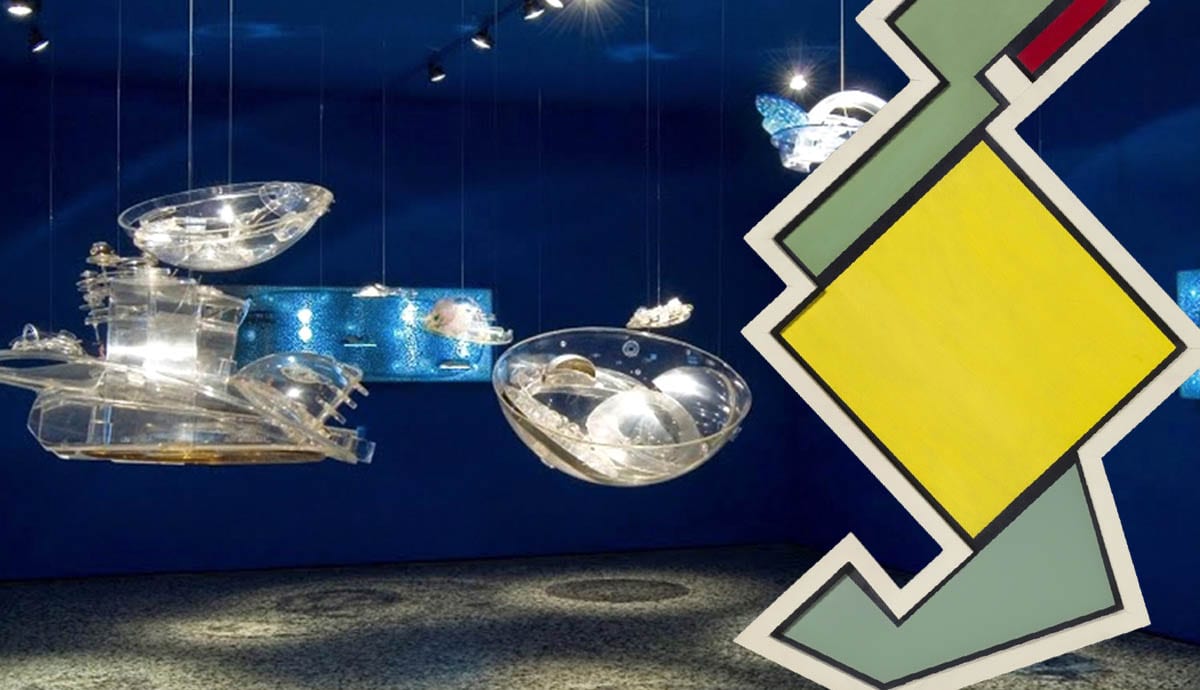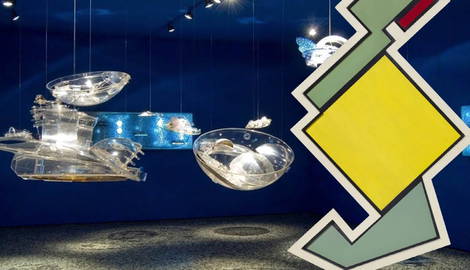
In exploring colors and shapes, painters find new ways to stray from realism while still acknowledging the existence of objects. Cubism celebrates pure, unadorned geometric forms; the Fauvists worshipped colors, making hues and saturations their main instruments; and the Impressionists strove to convey their emotion and mood through blurry mists of paint. The founders of the Madí movement were certainly not the first artists to wander the realms of possibilities offered by plain geometry, nor were they the last to discover abstract art. The Madí movement was unique in their mathematical approach and their revolutionary attitude toward “traditional” art, inherited from the heralds of the 1917 Russian Revolution and the Italian Futurists.
What Are The Origins Of The Madí Movement?

Whenever a new art trend emerges, it tends to appear as a response to political developments, rebelling against norms and reinforcing change. Russian avant-garde, for example, hailed the revolution and the new regime, breaking away from old tradition. In celebrating innovation, avant-gardists strove to eclipse their predecessors. In other cases, however, art supports the ruling class, reacting positively to their policies and glorifying their achievements. Socialist Realism, for example, supported the idea of ‘real’ values, praising the successes of a new state.
The story of the Madí movement is not too different. It is, in many ways, a product of the confusing post-war reality seen through the lenses of several inquisitive artists tired of politics.
The Madi movement started in Argentina, when most of the world was still reeling from the aftermath of the devastating Second World War. Since Juan Peron, Argentina’s leader, relied on photography to boost his popularity, realistic portrayals occupied an important role in all state-sponsored propaganda. Although Peron did not explicitly suppress abstract art, he did not support it, preferring realistic paintings documenting his deeds and glorifying his policies. Carmelo Arden Quin, however, could not be further from politics in either Argentina or in his native Uruguay. He believed that aesthetic progress could only be achieved through cool, scientific rationality that could control imaginative flights and mold them into new forms for new times. Inspired by Joaquín Torres-Garcia, the famous adept of “Constructive Universalism,” Arden Quin chose geometry over politics and ideologies.
Arden Quin conceived of Madí in 1946, drawing inspiration from Cubism, Futurism, and Constructivism: his art departed from politics and everyday agendas altogether due to Juan Peron’s dictatorship. Abstract art allowed Arden Quin to express himself in such a way that neither Peron’s regime nor its opposition could ban or twist his creations.

Above all else, his new way of creating art made it immune to propaganda. After all, abstract art can often be difficult to decipher. While a piece such as Delacroix’s Liberty Leading the People sends a clear message about France, Romantic Nationalism, and revolutions, a Madí artwork can be subjected to at least a dozen of interpretations. Thus, Madí, as intended by its founders, does not lend itself well to propaganda or any kind of ideological agenda.
The Madí movement took off during a precarious period when most of the world was still reeling from the aftermath of the devastating Second World War. In Argentina, the first Madi artists were skeptical of Juan Peron’s aesthetics and political views. Instead, they existed on the margins. A lot about the Madí is speculation, and this is precisely the intention of the artists. The name Madí itself does not have a clear origin story.
The invention of the Madí name is attributed to Gyula Košice, who worked under the pseudonym Raymundo Rasas Pet in Argentina. According to him, the name is derived from the Spanish Republican Motto used to rally crowds against Francoist Forces. They would shout: Madrí, Madrí, no pasarán (“Madrid, Madrid, they will not pass.”) A less dramatic story presents the name as an acronym for Movimiento, Abstracción, Dimensión, Invención (Movement, Abstraction, Dimension, Invention). Analyzing the ever-changing world through non-figurative concrete art, Rhod Rothfuss, Gyula Kosice, and Carmelo Arden Quin, the three founders of Madí, strove to create an artistic movement that could become all-inclusive.
Madí, Abstract Art’s International Movement

In their first manifesto written in 1946, Kosice, Quin, and Rothfuss proclaimed the importance of “the true constructive spirit which has spread through all countries and cultures.” Unlike many artistic trends and movements, Madí does not rely on a strong national component. Impressionism, for example, started in France and initially encompassed primarily French artists. Similarly, early Futurism began in Italy before spreading to other countries. Expressionism was envisioned by disillusioned German artists, whose works reflected their desperate reaction to the collapse of their state after World War I.
Madí, on the other hand, did not start as a purely Argentinian movement. Its founders were two natives of Uruguay and a Hungarian who resided in Argentina. Some believe that by its very nature, Madí may be one of the most inclusive and international artistic movements of the last century. It remains this way today, welcoming artists from all over the world.
Abstract art, according to the founders of the Madí movement, transcends borders. It has no nation and no allegiance, making it a perfect form of expression for those who want to see beyond boundaries, defying strict characterization. In the late 1940s, Madí shared its fascination with abstract art with another Argentinian group: the Asociación Arte Concreto-Invención.
The difference between the two lay in Madí’s broader grasp of art. Madí artists painted on irregular-sized canvases and experimented with geometrical forms, adding three-dimensional objects to their works and engaging with other art forms such as poetry or music. To promote their ideas and target an international audience, the group published a journal called Arte Madí Universal.
How Madí Breaks Boundaries

As an abstract movement, Madí highlights objects and colors themselves, unattached to associated social constructs. Arden Quin, for example, describes a drawing as “an arrangement of points and lines on a surface that creates form or a relationship of planes.” What does this geometry represent? First and foremost, it blends math with art and creates images that are equally understandable, or sometimes equally incomprehensible, to everyone.
Most Madi artworks reference the future, science, and new ways of seeing familiar things. For example, Košice’s Luminescent Circles and Line of Moving Water is a work of art that cannot be fully appreciated in two dimensions. It combines the familiar circular forms with dots of light and water droplets in a straw-like tube. When brought together, these elements create a provocative piece that forces one to think outside of the box.
Similarly, Košice’s Hydrospatial City depicts an entire model of a futuristic urban habitat that may as well inspire modern science fiction writers. Košice believed that architecture in space would flow like water without boundaries. Again, the notion of finding a new way of designing cities and bringing change fascinated Košice. Obsessed with motion and change, many Madí artists turned to the so-called kinetic art that demonstrates movement viewable to the audience. Soon after the start of the movement, Košice’s hydrospatial walks and hydro walls became the pioneering pieces of kinetic art in Argentina, solidifying the message of Madí and its desire to erase barriers and fascinate the public.

Much like his art, Košice was an international figure who transcended national or cultural codes and forged his own path. A Hungarian born in modern-day Slovakia, he became one of the first people to experiment with new materials in abstraction. He created luminance structures with neon gas and invented hydraulic sculpture, using water as his essential material in the same way that most sculptors use stone or wood. Košice’s fame went as far as to warrant him a whole exhibition room at the Centre Pompidou’s Multiple Modernities Exhibition in Paris in 2014. To celebrate his achievements, the organizers even included Röyi – a wooden sculpture considered one of the first Argentinian abstract pieces.
Similar to Košice, Arden Quin strove to leave all kinds of borders behind while still supporting his artistic connections to Argentina as well as his native Uruguay. He met Rhod Rothfuss, the third founder of Madí, during one of his brief visits home when he was attending an exhibition. Later, the three artists started expanding the ideas of what abstract art could do, popularizing their own artwork, publishing journals, and actively engaging with their opponents and sympathizers alike. For them, abstract art could unite individuals despite differing political views and national affiliations. Rhod Rothfuss wrote that “a painting should be something that begins and ends in itself.” His Yellow Quadrangle is exactly that – a piece of geometrical forms combined in an unusual manner.

After Arden Quin moved to Paris, the Madí movement started attracting even more artists and spectators. Arden Quin exhibited his works in the Salon des Realités in Paris, where he achieved worldwide recognition before returning to Buenos Aires and launching the Association of New Art (Associacion Arte Nuevo). Later, his first major retrospective took place at Alexandre LaSalle’s Saint-Paul-de-Vence gallery. In the 1960s, Arden Quin turned to mobile art, while in the 1970s, he started experimenting with the H form and the notions of symmetry.
Inspired by Torres-García and his Constructivist approach to art, Arden Quin developed an interest in the “golden ratio” – a proportion used to create harmonious compositions. Researching the possibilities that the golden ratio could offer, Arden Quin compared various geometric forms, applying mathematical analysis to visual perception and studying the harmonious H form – a perfectly symmetrical combination of lines. His exploration of the subject led him to interesting results. His later work culminated in his efforts to create multiple art pieces while preserving the original forms. In this way, he arrived at the idea of coplanars combined to create mobile pieces and other unexpected contraptions. Among the many coplanars that he brought to life, perhaps, the Helicon is one of the most famous.
The Madí Today: What Does Their Future Hold?

In 2004, the artist Roger Neyrat wrote that “Madí is a great artistic adventure, and perhaps, the only existing movement which can justify half a century of existence. Madi is more than an avant-garde movement; it has an underlying wave with several and differing offspring.” Part of Madí’s inclusivity justifies this claim. How can geometry and the endless variety of three-dimensional forms ever become irrelevant if new artists continue to find original ways to fuse multiple artforms – poetry, sculpture, painting, dance?
Nowadays, the Geometric Madí Museum in Dallas, as well as another Madi museum situated in Vac, Hungary, continuously expand their expositions, bringing more artists and non-artists into the circle while the movement continues to grow. Even the building that houses the Madí Art Museum and Gallery in Dallas is a work of art. Once a storefront building, the new Kilgore Law Center was built in the 1970s by Roitman, who played with lasers on vividly colored metal panels to create an impression of geometric shapes floating against a free-form background. In the end, the building became a perfect home for Madí art, reflecting its essence.
Madí is always colorful, often three-dimensional, and sometimes even contains moving parts. The choices it offers are endless. So, what is the Madí movement? Madí focuses on objects rather than interpretation; it does not promote political ideologies. Its philosophy is the geometrical thesis and antithesis. In the end, there is no secret to Madí. It is simply what you see.










